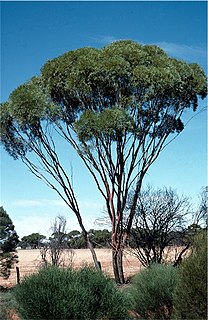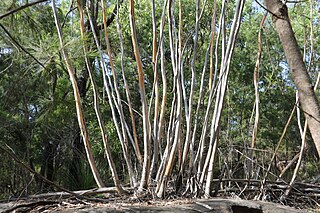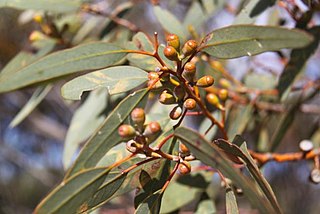
Eucalyptus gregsoniana, commonly known as the Wolgan snow gum or mallee snow gum, is a species of mallee that is endemic to New South Wales. It has white to pale grey bark, lance-shaped to curved adult leaves, flower buds in groups of between seven and eleven, white flowers and cup-shaped, hemispherical or conical fruit.

Eucalyptus kochii, commonly known as oil mallee, is a species of mallee, sometimes a tree, and is endemic to Western Australia. It has rough, flaky or fibrous bark on the trunk, smooth grey bark above, linear to narrow lance-shaped adult leaves, flower buds in groups of nine to fifteen, white flowers and urn-shaped fruit.

Eucalyptus burgessiana, commonly known as the Faulconbridge mallee ash, is a small tree or mallee that is endemic to New South Wales. It has smooth bark, narrow lance-shaped or curved adult leaves, flower buds arranged in groups of between seven and eleven, white flowers and barrel-shaped or cup-shaped flowers.
Eucalyptus nitida, commonly known as the Smithton peppermint, is a species of tree or mallee that is endemic to Tasmania. It has varying amounts of loose, fibrous or flaky bark, lance-shaped to curved adult leaves, flower buds in groups of nine to fifteen, white flowers and cup-shaped to hemispherical fruit.

Eucalyptus cunninghamii, commonly known as cliff mallee ash, is a species of mallee that is endemic to the Blue Mountains in New South Wales. It has smooth grey bark, often with insect "scribbles", linear to narrow lance-shaped adult leaves, flowers buds in groups of seven or nine, white flowers and urn-shaped, barrel-shaped or more or less spherical fruit. It grows on cliff edges and upper edges of valleys.

Eucalyptus stricta, commonly known as Blue Mountains mallee ash, is a mallee that is endemic to eastern New South Wales. It has smooth, mottled bark, often with insect scribbles, linear to lance-shaped adult leaves, flower buds in groups of seven, white flowers and urn-shaped to barrel-shaped fruit.

Eucalyptus multicaulis, commonly known as the whipstick mallee ash, is a species of mallee that is endemic to New South Wales. It has smooth bark, lance-shaped or curved adult leaves, oval to club-shaped flower buds in groups of between seven and fifteen, white flowers and conical fruit.

Eucalyptus apiculata, commonly known as the narrow-leaved mallee ash and is a mallee that is endemic to New South Wales. It has smooth white or greyish bark, narrow lance-shaped adult leaves, flower buds in groups of three to seven, white flowers and urn-shaped or barrel-shaped fruit.

Eucalyptus eremicola, commonly known as Vokes Hill mallee, is a species of mallee that is native to South Australia and Western Australia. It has rough bark near the base, smooth bark above, linear to lance-shaped adult leaves, flower buds in groups of between nine and fifteen, white flowers and shortened spherical fruit.

Eucalyptus obtusiflora, commonly known as Dongara mallee, is a species of mallee that is endemic to Western Australia. It has smooth greyish or brownish bark that is often imperfectly shed, lance-shaped to curved adult leaves, flower buds usually in groups of seven or nine, creamy white flowers and cup-shaped, conical or barrel-shaped fruit.
Eucalyptus olivina is a species of mallee or a tree that is endemic to Western Australia. It has smooth greyish bark, linear to narrow lance-shaped adult leaves, flower buds in groups of seven or nine, creamy white flowers and short barrel-shaped to cup-shaped fruit.

Eucalyptus platycorys, commonly known as Boorabbin mallee, is a species of mallee, rarely a small tree, that is endemic to Western Australia. It has rough, dark grey, fibrous and flaky bark on the trunk, smooth greyish bark above, lance-shaped adult leaves, flower buds usually in group of three, creamy white flowers and cup-shaped to cylindrical fruit.
Eucalyptus quadrans is a species of mallee or a small tree that is endemic to the southwest of Western Australia. It has smooth, greyish bark, narrow lance-shaped adult leaves, flower buds in groups of seven, white flowers and cup-shaped fruit that are square in cross-section.
Eucalyptus semota, commonly known as marymia mallee, is a species of mallee or small tree that is endemic to a small area in central Western Australia. It has rough, flaky to fibrous bark on the trunk, smooth grey or brown bark above, linear to narrow lance-shaped leaves, flower buds in groups of seven or nine, white flowers and conical to cup-shaped fruit.
Eucalyptus remota, commonly known as the Kangaroo Island ash, Kangaroo Island mallee ash, or Mount Taylor mallee, is a species of tree or mallee that is endemic to Kangaroo Island in South Australia. It has smooth bark, often with rough, fibrous bark on the trunk, lance-shaped adult leaves, flower buds in group of between nine and twenty one, white flowers and hemispherical or shortened spherical fruit.

Eucalyptus diversifolia, commonly known as the soap mallee, coastal white mallee, South Australian coastal mallee, or coast gum is a species of mallee that is endemic to an area along the southern coast of Australia. It has smooth bark, lance-shaped adult leaves, flower buds in groups of between seven and eleven, white to creamy yellow flowers and cup-shaped fruit.

Eucalyptus froggattii, commonly known as the Kamarooka mallee, is a species of mallee or small tree that is endemic to Victoria. It has rough, crumbly, blackish bark on the trunk, smooth grey to brown bark above, lance-shaped adult leaves, four-sided flower buds in groups of between seven and eleven, white or cream-coloured flowers and four-sided, cup-shaped to pear-shaped fruit.

Eucalyptus willisii, also known as shining peppermint or promontory peppermint, is a species of small to medium-sized tree, sometimes a mallee that is endemic to Victoria, Australia. It has rough, fibrous bark on the trunk and branches, lance-shaped to curved adult leaves, flower buds in groups of eleven to twenty five, white flowers and cup-shaped or hemispherical fruit.
Eucalyptus longissima is a species of mallee or small tree that is endemic to the south-west of Western Australia. It has rough, fibrous or stringy bark on the trunk, smooth greyish brown bark above, glossy green, lance-shaped adult leaves, flower buds in group of between seven and thirteen, white flowers and shortened spherical fruit.
Eucalyptus silvestris is a species of mallee or small tree that is endemic to Victoria, Australia. It has rough, fibrous or flaky bark on the trunk and larger branches, smooth greyish brown bark above, glossy green, lance-shaped leaves, flower buds usually in groups of seven, white flowers and conical to cup-shaped fruit.















